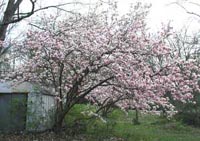Resource Library
Plant of the Week: Saucer Magnolia
The University of Arkansas System Division of Agriculture does not promote, support or recommend plants featured in "Plant of the Week." Please consult your local Extension office for plants suitable for your region.
Plant of the Week
Saucer Magnolia
Latin: Magnolia x soulangiana

Every gardener is a bit of a gambler or they would never plant saucer magnolias. This beautiful tree blooms early and the risk of losing the flowers to a spring frost is great; but when they make it the payout is high. This spring has been one of those perfect years for saucer magnolia, reminding us anew of what beauty this early spring bloomer can produce.
Saucer magnolia (Magnolia x soulangiana) is a slow growing, low-branched, deciduous tree capable of reaching 25 feet in height and width. In late winter, the fuzzy gray, pinky-sized buds expand rapidly and produce 5-inch diameter, cup-shaped blooms, usually with nine petals. The tulip shaped blossoms give rise to the common name, tulip tree. The outer surface of the petals are pinkish-purple while the inner surface is white. The Chinese have a wonderful name for these magnolias - Yingchunhua - which means "welcoming-spring flower."
These large exposed buds tolerate midwinter temperatures as low as minus 20 degrees Fahrenheit, but once the flower opens even the threat of a frost on the evening news turns the petals to mush. The flower buds have a short chilling requirement to break dormancy, something on the order of 600 hours. Temperatures around 40 degrees F (give or take 5 degrees) are logged by the dormant bud, and when the requisite number of chilling hours is met, the buds are ready to open with the first sunny day.
Controlled hybrids were first created in 1820 by Etienne Soulange-Bodin (1774-1846), a cavalry officer in the service of Napoleon who fought in battles from Vienna to Moscow. After the defeat at Waterloo, Soulange-Bodin gave up the sword in favor of his garden spade.
Soulange-Bodin described the species used in his crosses as M. yulan (now M. denudata) x M. purpurea (now M. quinquipeta). His initial hybrids first flowered in 1827 and were found to be fertile, so he and other breeders quickly began adding to and expanding the offering in this hybrid species. Today, about 50 selections are listed with many of them similar in appearance and garden performance.
The vagaries of our weather usually provide a few false starts to spring, so early bloomers such as the saucer magnolia often get caught with their pants down. Here in Fayetteville, and from what I have observed in other areas, count on show-stopping displays from the saucer magnolia about once every three years. But when it hits big, you'll quickly forget the disappointment caused by years when it gets blasted.
The bloom time for early spring bloomers is affected by planting location. North slopes and the north side of the home don 't get as much winter sun, so the soil stays cooler and blooming is delayed. Conversely, south slopes and the south side of the house warm up first and plants bloom first.
Saucer magnolias are precocious bloomers and usually well-budded even as 5-foot tall specimens. Landscape uses include planting for dooryard specimens, as lawn specimens and mixed with other landscape plants in a flowering border.
Because they are relatively small at maturity, they can be planted close to the house or patio without fear the coarse roots damaging the structure. They are slow growing, so give them the best advantage by planting in a fertile, well-drained garden soil that receives some supplemental watering during summer droughts.
By: Gerald Klingaman, retired
Extension Horticulturist - Ornamentals
Extension News - March 28, 2003
The University of Arkansas System Division of Agriculture does not maintain lists of retail outlets where these plants can be purchased. Please check your local nursery or other retail outlets to ask about the availability of these plants for your growing area.